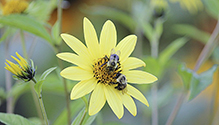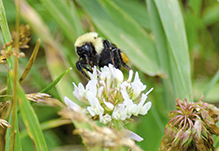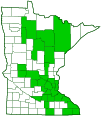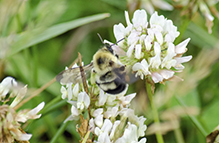Two-spotted bumble bee
(Bombus bimaculatus)
Conservation • Description • Habitat • Ecology • Distribution • Taxonomy
|
|
||||||||||||||
Description |
Two-spotted bumble bee is a common, small, colonial, ground-nesting bumble bee. The female (worker) bee is 7 ⁄16″ to ⅝″ long. The upper side of the thorax is black but is densely covered with short yellow hairs. There is a small, round spot in the middle that is , more or less bare and more or less fringed with short black hairs. At the base of each wing there is a shiny, black bare plate (tegula). There are six abdominal segments. The first segment is densely covered with yellow hairs. Segment 2 has a broad yellow spot across the middle third at the leading (anterior) edge that extends nearly to the trailing (posterior) edge of the segment. It may be indented in the middle appearing as two connected spots or a rounded “W”. Segments 3 through 6 are entirely black and densely covered with short black hairs. The hairs on the head are mostly black. There is a dense tuft of black hairs on the top of the head (vertex) and a dense tuft of yellow hairs on the back of the head. There are two large compound eyes, one on each side of the head; and three small simple eyes (ocelli) in a triangular pattern at the top of the head between the compound eyes. The middle ocellus is larger than the the two lateral ones. The top of the small (lateral) ocelli are on a virtual line (supraorbital line) with the top of the compound eyes. The area between the bottom margin of the compound eye and the base of the mandible, called the malar space, is relatively long. The antennae have 12 segments. The first antenna segment is slightly shorter than than the second and third combined. The tongue is very long. The wings and legs are black. The queen is similar to the worker but larger, ⅝″ to ⅞″ long. The male (drone) is similar but has 7 abdominal segments and 13 antennae segments. The hairs on the back of the head are yellow, like the female, but those on the front of the head are mixed black and yellow. Abdominal segments 3 through 7 have variable amounts of yellow and black hairs. Segment 2 on some individuals is entirely yellow. Segments 4 and 5 are mostly yellow on some individuals. The compound eyes are not larger than those of the female. |
Size |
Queen: ⅝″ to ⅞″ Male: ½″ to 9 ⁄16″ Worker: 7 ⁄16″ to ⅝″ |
Similar Species |
Brown-belted bumble bee (Bombus griseocollis) yellow spot on abdominal segment 2 is U-shaped and extends less than half way to the posterior edge of the segment. The hairs on the back of the head of the female are black. The eyes on the male are much larger. |
Habitat |
Woodland habitats |
Ecology |
Season |
Very early spring to mid-summer; March to September |
Behavior |
Bumble bees will sting to protect themselves or their nest. The stinger is not barbed and the bee can sting multiple times. |
Life Cycle |
Overwintering queens emerge from hibernation in March. They nest mostly underground but sometimes above ground or in cavities in dead trees. |
Larva Food |
Larvae are fed both nectar for carbohydrates and pollen for protein. |
Adult Food |
Adults feed mostly on nectar but also on some pollen. The very long tongue allows it to feed on nectar of plants with long corolla tubes. |
Distribution |
||
|
Sources Biodiversity occurrence data published by: Minnesota Biodiversity Atlas (accessed through the Minnesota Biodiversity Atlas Portal, bellatlas.umn.edu, 8/18/2025). |
|
| 8/18/2025 | ||
Occurrence |
||
Common in eastern North America |
||
Taxonomy |
|
Order |
Hymenoptera (Ants, Bees, Wasps, and Sawflies) |
Suborder |
Apocrita (Narrow-waisted Wasps, Ants, and Bees) |
Infraorder |
Aculeata (Ants, Bees, and Stinging Wasps) |
Superfamily |
Apoidea (Bees and Apoid Wasps) |
Epifamily |
|
Family |
Apidae (honey bees, bumble bees, and allies) |
Subfamily |
Apinae (honey, bumble, longhorn, orchid, and digger bees) |
Tribe |
Bombini |
Genus |
|
Subgenus |
Pyrobombus |
Subordinate Taxa |
|
|
|
Synonyms |
|
Bombus ridingsii Bremus bimaculatus Bremus bimaculatus ahenus Bremus bimaculatus arboreti |
|
Common Names |
|
two-spotted bumble bee |
|
Glossary
Malar space
In Hymenoptera, the space, equivalent to the cheek, between the bottom of the compound eye and the base of the mandible.
Ocellus
Simple eye; an eye with a single lens. Plural: ocelli.
Tegula
A small, hardened, plate, scale, or flap-like structure that overlaps the base of the forewing of insects in the orders Lepidoptera, Hymenoptera, Diptera, and Homoptera. Plural: tegulae.
Vertex
The upper surface of an insect’s head.
Minnesota Bumble Bee Identification Guide
The University of MN Bee Lab has a free field identification guide to Minnesota bumble bees. It is indispensable for amateur naturalists or anyone wanting to identify the bumble bee in their photo. Click on the image below to download the guide.
Visitor Photos |
||
Share your photo of this insect. |
||
This button not working for you? |
||
Bobbi Johnson |
 |
Christa Rittberg |
||
 |
||
MinnesotaSeasons.com Photos |
||
|
||
|
||

Slideshows |
|

Visitor Videos |
||
Share your video of this insect. |
||
This button not working for you? |
||
Gerry Garcia |
two spotted bumble bee 01 |
About
two-spotted bumble bee (Bombus bimaculatus) Lyndale Park, Minneapolis, MN Video by Gerry Garcia http://www.minnesotaseasons.com/Insects/two-spotted_bumble_bee.html |
two spotted bumble bee 02 |
About
two-spotted bumble bee (Bombus bimaculatus) Lyndale Park, Minneapolis, MN Video by Gerry Garcia http://www.minnesotaseasons.com/Insects/two-spotted_bumble_bee.html |
Other Videos |
||
Two-spotted Bumble Bee (Apidae: Bombus bimaculatus) Queen |
About
Published on May 6, 2011 Hooray! Fertile Queen Bumble Bees finally emerged from their long, long, long winter's nap this week! Photographed at Grand Forks, North Dakota (06 May 2011). Thank you to 'robomantis' for identifying this specimen! |
Wild Two-Spotted Bumble Bee Nest (Bombus bimaculatus) |
About
Published on Jul 27, 2016 Found in a meadow/old field area on an organic farm near London, Ontario on July 10, 2016. |
Bombus bimaculatus mating |
About
Published on Jul 15, 2013 Bombus bimaculatus bumble bees mating early in the morning. |
Two-spotted Bumble Bee (Apidae: Bombus bimaculatus) on Blossom |
About
Published on Aug 13, 2010 Photographed at Grand Forks, North Dakota (13 August 2010). |
Bumble bee (Bombus bimaculatus) on Wild Senna (Senna hebecarpa) |
About
Tom Wassmer det. Sam Droege (Thanks!) |

Visitor Sightings |
||
Report a sighting of this insect. |
||
This button not working for you? |
||
Gerry Garcia |
Location: Lyndale Park, Minneapolis, MN |
Crystal Boyd |
Location: Uncas Dunes SNA |
MinnesotaSeasons.com Sightings |
||

Created: 7/4/2017 Last Updated: © MinnesotaSeasons.com. All rights reserved. |


